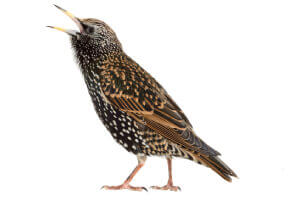The Common Starling
Starlings are known to cause significant building damage due to their aggressive nesting behavior. They dig out cavities to build nests from the smallest cracks and crevices to start. Starlings peck and slash to create these cavities, causing considerable damage and compromising structural integrity. This isn’t because they want to just destroy our facilities. It’s based on their behavior of nesting in caverns or other areas where they have to dig crevices to nest. Doesn’t make them any less destructive, though.

Additionally, their corrosive droppings can damage all kinds of materials and surfaces including lumber, concrete, or even steel. While you may not see starlings much in the summer since they often go out to rural areas, they are likely to return each fall to overwinter and nest their next brood in the spring inside your buildings.
Now considered one of the worst public health risk birds in this country, Old World starlings were purposely introduced to Central Park, New York City in 1890 by a well-meaning but misguided group who wanted to have all of the birds mentioned in Shakespearean plays in Central Park. While it took several tries, a group of 60 pairs that were released eventually multiplied and the population grew rapidly. Soon after, the American starling population exploded, and the species spread rapidly throughout the entire U.S. and much of Canada. Starlings are now considered an invasive species and are despised by ecologists, birder enthusiasts, and business owners alike.
What Do Starlings Eat
Starlings are omnivores that feed on nuts, berries, seeds, grains, and many kinds of invertebrates like caterpillars, worms, larvae, and spiders. Their vast diet ensures they can survive in many different places. While they prefer insects, their high energy demands will make them eat a lot of other things other than their favorites. Starlings are world-renowned for their insatiable appetites and will feast upon everything from seeds and grains to insects all year round, including in the winter. They do tend to consume more insects throughout late winter and the breeding season from early March until the end of summer. During the summer, starlings will also consume berries, nuts, grains, and seeds, often becoming a significant agricultural pest in American farmlands. Their intestine will lengthen slightly to accommodate this more fiber-heavy diet from raw agricultural commodities.
Starling Nest
Starlings only nest in cavities and are happy to use those provided by man-made facilities including a stove, a dryer, and exhaust fan vents. If there’s a gap in a cinder block wall, the interior cavities are perfect for nesting clutches. They also love the bird houses we put up. They nest in loose colonies and do not establish and defend a proper territory – only the immediate area around the nesting cavity is defended. The whole colony feeds communally in what is termed a home range. To attract a mate, the male builds the base of the nest from dry grass and leaves in a hole and sings from perches close to the nest entrance. The female completes the nest by making a nest cup and lining it with fine grasses, moss, and feathers. They are well known for large flock flight patterns that meander as they leave the nests in the spring or return from the farmlands in the fall This unique flight pattern is called murmuration and it can be mesmerizing.
Starlings Sounds
Starlings can warble, whistle, chatter, make smooth liquid sounds, harsh trills, and rattles, and imitate meadowlarks, jays, and hawks. Starling sounds tend to consist of either loud whistles or softer, jumbled warbling. Whistled songs are a few seconds long, often used between males. They are talented singers!
How to Get Rid of Starlings
Unfortunately, you don’t want to have bird houses in your yard. Bird feeders won’t always attract starlings since they don’t like suet but if you’re putting seeds in, it will be full of them! And they are not kind to other birds in the area. Starlings are known to compete with, displace, and kill many native birds and their young. So, yeah, you don’t want to go attracting them in the first place. That’s the best way to get rid of them. But once they’re already around, the following strategies can be used for getting rid of starlings:
Starling Deterrents & Starling Repellent
Nets and mesh are popular ways to exclude starlings and similar sized birds from specific areas. These methods physical block a space. Ledge guards will stop many kinds of birds from landing on your ledges and can deter them from your buildings. Bird spikes and tension wire can be effective in deterring the birds as well. And contrary to popular belief, they don’t hurt birds. They just make landing inhospitable – easy starling repellent (as well as many other birds). Tension wires and spider-legs are mostly for commercial buildings because they create a bird deterrent that is also aesthetically pleasing, therefore not disturbing the architecture.
Starling Control & Starling Pest Control
You can use the remedies we mentioned above especially the ones we noted that will help you not attract starlings. Real starling control should be done by a professional company, in a humane way. While they may be annoying and nuisances, they really are just trying to live in the eco-system like the rest of us. So, keeping them off a home or building is important but just getting them back into nature is important, too. So, make sure you choose a bird pest control company that can do both.